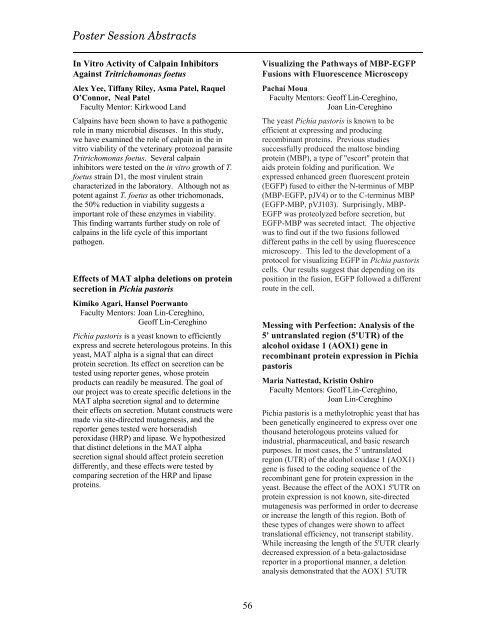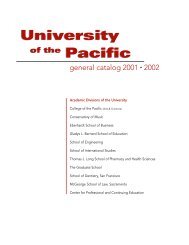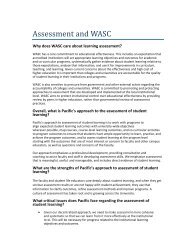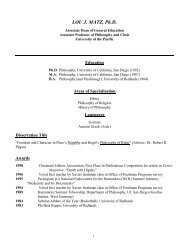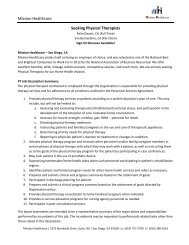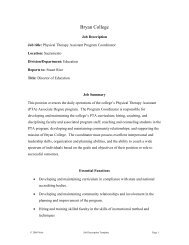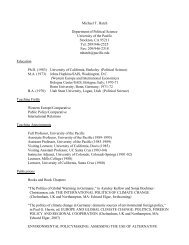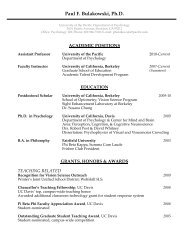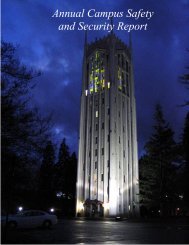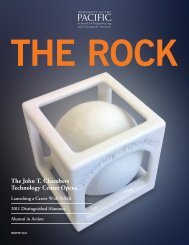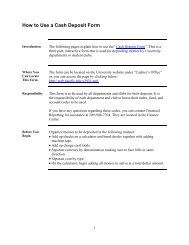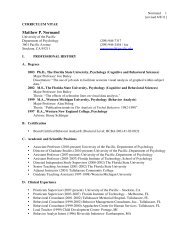purcc 2012 - University of the Pacific
purcc 2012 - University of the Pacific
purcc 2012 - University of the Pacific
Create successful ePaper yourself
Turn your PDF publications into a flip-book with our unique Google optimized e-Paper software.
Poster Session Abstracts<br />
In Vitro Activity <strong>of</strong> Calpain Inhibitors<br />
Against Tritrichomonas foetus<br />
Alex Yee, Tiffany Riley, Asma Patel, Raquel<br />
O’Connor, Neal Patel<br />
Faculty Mentor: Kirkwood Land<br />
Calpains have been shown to have a pathogenic<br />
role in many microbial diseases. In this study,<br />
we have examined <strong>the</strong> role <strong>of</strong> calpain in <strong>the</strong> in<br />
vitro viability <strong>of</strong> <strong>the</strong> veterinary protozoal parasite<br />
Tritrichomonas foetus. Several calpain<br />
inhibitors were tested on <strong>the</strong> in vitro growth <strong>of</strong> T.<br />
foetus strain D1, <strong>the</strong> most virulent strain<br />
characterized in <strong>the</strong> laboratory. Although not as<br />
potent against T. foetus as o<strong>the</strong>r trichomonads,<br />
<strong>the</strong> 50% reduction in viability suggests a<br />
important role <strong>of</strong> <strong>the</strong>se enzymes in viability.<br />
This finding warrants fur<strong>the</strong>r study on role <strong>of</strong><br />
calpains in <strong>the</strong> life cycle <strong>of</strong> this important<br />
pathogen.<br />
Effects <strong>of</strong> MAT alpha deletions on protein<br />
secretion in Pichia pastoris<br />
Kimiko Agari, Hansel Poerwanto<br />
Faculty Mentors: Joan Lin-Cereghino,<br />
Ge<strong>of</strong>f Lin-Cereghino<br />
Pichia pastoris is a yeast known to efficiently<br />
express and secrete heterologous proteins. In this<br />
yeast, MAT alpha is a signal that can direct<br />
protein secretion. Its effect on secretion can be<br />
tested using reporter genes, whose protein<br />
products can readily be measured. The goal <strong>of</strong><br />
our project was to create specific deletions in <strong>the</strong><br />
MAT alpha secretion signal and to determine<br />
<strong>the</strong>ir effects on secretion. Mutant constructs were<br />
made via site-directed mutagenesis, and <strong>the</strong><br />
reporter genes tested were horseradish<br />
peroxidase (HRP) and lipase. We hypo<strong>the</strong>sized<br />
that distinct deletions in <strong>the</strong> MAT alpha<br />
secretion signal should affect protein secretion<br />
differently, and <strong>the</strong>se effects were tested by<br />
comparing secretion <strong>of</strong> <strong>the</strong> HRP and lipase<br />
proteins.<br />
Visualizing <strong>the</strong> Pathways <strong>of</strong> MBP-EGFP<br />
Fusions with Fluorescence Microscopy<br />
Pachai Moua<br />
Faculty Mentors: Ge<strong>of</strong>f Lin-Cereghino,<br />
Joan Lin-Cereghino<br />
The yeast Pichia pastoris is known to be<br />
efficient at expressing and producing<br />
recombinant proteins. Previous studies<br />
successfully produced <strong>the</strong> maltose binding<br />
protein (MBP), a type <strong>of</strong> "escort" protein that<br />
aids protein folding and purification. We<br />
expressed enhanced green fluorescent protein<br />
(EGFP) fused to ei<strong>the</strong>r <strong>the</strong> N-terminus <strong>of</strong> MBP<br />
(MBP-EGFP, pJV4) or to <strong>the</strong> C-terminus MBP<br />
(EGFP-MBP, pVJ103). Surprisingly, MBP-<br />
EGFP was proteolyzed before secretion, but<br />
EGFP-MBP was secreted intact. The objective<br />
was to find out if <strong>the</strong> two fusions followed<br />
different paths in <strong>the</strong> cell by using fluorescence<br />
microscopy. This led to <strong>the</strong> development <strong>of</strong> a<br />
protocol for visualizing EGFP in Pichia pastoris<br />
cells. Our results suggest that depending on its<br />
position in <strong>the</strong> fusion, EGFP followed a different<br />
route in <strong>the</strong> cell.<br />
Messing with Perfection: Analysis <strong>of</strong> <strong>the</strong><br />
5' untranslated region (5'UTR) <strong>of</strong> <strong>the</strong><br />
alcohol oxidase 1 (AOX1) gene in<br />
recombinant protein expression in Pichia<br />
pastoris<br />
Maria Nattestad, Kristin Oshiro<br />
Faculty Mentors: Ge<strong>of</strong>f Lin-Cereghino,<br />
Joan Lin-Cereghino<br />
Pichia pastoris is a methylotrophic yeast that has<br />
been genetically engineered to express over one<br />
thousand heterologous proteins valued for<br />
industrial, pharmaceutical, and basic research<br />
purposes. In most cases, <strong>the</strong> 5' untranslated<br />
region (UTR) <strong>of</strong> <strong>the</strong> alcohol oxidase 1 (AOX1)<br />
gene is fused to <strong>the</strong> coding sequence <strong>of</strong> <strong>the</strong><br />
recombinant gene for protein expression in <strong>the</strong><br />
yeast. Because <strong>the</strong> effect <strong>of</strong> <strong>the</strong> AOX1 5'UTR on<br />
protein expression is not known, site-directed<br />
mutagenesis was performed in order to decrease<br />
or increase <strong>the</strong> length <strong>of</strong> this region. Both <strong>of</strong><br />
<strong>the</strong>se types <strong>of</strong> changes were shown to affect<br />
translational efficiency, not transcript stability.<br />
While increasing <strong>the</strong> length <strong>of</strong> <strong>the</strong> 5'UTR clearly<br />
decreased expression <strong>of</strong> a beta-galactosidase<br />
reporter in a proportional manner, a deletion<br />
analysis demonstrated that <strong>the</strong> AOX1 5'UTR<br />
56


